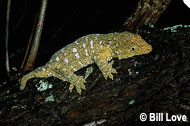Description:
The New Caledonian giant gecko is the largest living gecko in the world right now as far as overall bulk, which is part of its appeal as a pet. Its fleshy folds of skin make it ‘comfortable’ to handle, although not all specimens tolerate human handling. Most tame down well, though, because the vast majority in captivity are captive-bred and are raised around humans. They always hold onto a tendency to leap, so be prepared for when they jump from your arm to a nearby object. The New Caledonian giant gecko is a nocturnal prowler in trees, where it consumes many kinds of small animals from insects and spiders to other geckos. Nectar from flowers is also savored. In captivity, strained fruit-flavored baby food is licked up eagerly. In the wild, New Caledonian giant geckos may also take small fruits and berries like figs. Being rather sedentary, it’s best to take care in not overfeeding New Caledonian giant geckos because obesity in pets is common. ‘Leachies’ need vertical tree branches to climb on and inside, which is where they typically pass the daytime hours secreted from sight. At dusk New Caledonian giant geckos emerge to catch bugs and seek out fruit by slowly descending to near the ground where those prey items are more abundant. Twilight is the time to introduce food. Only one male New Caledonian giant gecko should inhabit a cage due to the intense fighting that may occur. Many adults have bobbed tails from interspecies aggression that’s largely attributed to male versus male fighting. The tails grow back, but even shorter and stubbier than the original ones.
Habitat:
Undisturbed forests with abundant rainfall
Range:
New Caledonia
Scientific Name: Rhacodactylus leachianus
Species Group: gecko
Family: Gekkonidae
Size: 8 to 14 inches total length
Level: intermediate
Weight:
Dangerous: No



